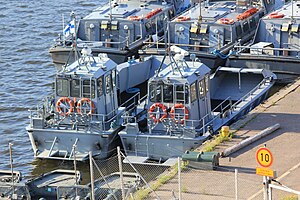The Royal Netherlands Navy is the naval force of the Kingdom of the Netherlands. It is one of the four Netherlands Armed Forces. It was founded on 8 January 1488, making it the third-oldest naval force in the world.

The Finnish Navy is one of the branches of the Finnish Defence Forces. The navy employs 2,300 people and about 4,300 conscripts are trained each year. Finnish Navy vessels are given the ship prefix "FNS", short for "Finnish Navy ship", but this is not used in Finnish-language contexts. The Finnish Navy also includes coastal forces and coastal artillery.

The Jurmo-class landing craft is a type of military transport in use by the Finnish Navy. The manufacturer Marine Alutech designates it as Watercat M12.
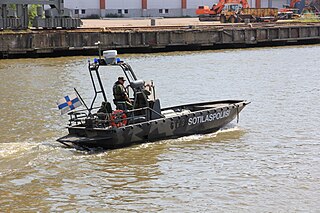
The G class, or "G-boat" also known as the Marine Alutech Watercat M8 landing craft is a type of vessel in use by the Finnish Navy and the Swedish Navy. The G-boat was originally designed for the Swedish Navy which ordered about 100 of them. It is primarily used for amphibious landings by, and transportation of, marines. It has a very low draught at high speeds which makes it ideal for amphibious assault even in shallow waters. It has a cargo capacity of 8 men or one metric ton.

The M242 Bushmaster chain gun is a 25 mm (25×137mm) single-barrel chain-driven autocannon. It is used extensively by the U.S. military, such as in the Bradley fighting vehicle, as well as by other NATO members and some other nations in ground combat vehicles and various watercraft. Hughes Helicopters in Culver City, California, was the original designer and manufacturer. As of 2019, Northrop Grumman Innovation Systems produces the gun.

A Landing Craft Utility (LCU) is a type of boat used by amphibious forces to transport equipment and troops to the shore. They are capable of transporting tracked or wheeled vehicles and troops from amphibious assault ships to beachheads or piers.

The Baltic Sea campaigns were conducted by Axis and Allied naval forces in the Baltic Sea, the Gulf of Bothnia, the Gulf of Finland and the connected lakes Ladoga and Onega on the Eastern Front of World War II. After early fighting between Polish and German forces, the main combatants were the Kriegsmarine and the Soviet Navy, with Finland supporting the Germans until 1944 and the Soviets thereafter. The Swedish Navy and merchant fleet played important roles, and the British Royal Navy planned Operation Catherine for control of the Baltic Sea and its exit choke point into the North Sea.

The Type 702 Berlin-class replenishment ship is a series of replenishment ships, originally designed and built for service in the German Navy. Designed to support United Nations overseas missions, the Berlin class were initially to number four vessels. However, three hulls were cut from the initial order. The lead ship, Berlin, began construction in 1999 and entered service in 2001. The second hull, Frankfurt am Main, was re-ordered in 1998, began construction in 2000 and entered service in 2002. The third hull, Bonn, was ordered in 2008 to a modified design, began construction in 2010 and entered service in 2013. All three ships are in service and are based at Wilhelmshaven.

Stridsbåt 90 H(alv) is a class of fast military assault craft used by several countries after being originally developed for the Swedish Navy by Dockstavarvet. Its name means Combat Boat 90 Half; the 90 refers to the year of acceptance (1990) and Half refers to the fact that it can carry and deploy a half platoon of amphibious infantry fully equipped. The CB90 is an exceptionally fast and agile boat that can execute extremely sharp turns at high speed, decelerate from top speed to a full stop in 2.5 boat lengths, and adjust both its pitch and roll angle while under way. Its lightweight, shallow draught, and twin water jets allow it to operate at speeds of up to 40 knots (74 km/h) in shallow coastal waters. The water jets are partially ducted, which, along with underwater control surfaces similar to a submarine's diving planes, gives the CB90 its manoeuvrability.

The Estonian Navy are the unified naval forces among the Estonian Defence Forces.
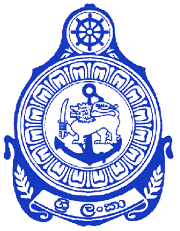
The Sri Lanka Navy (SLN) is the naval arm of the Sri Lanka Armed Forces and is classed as the country's most vital defence force due to its island geography and is responsible for the maritime defence of the Sri Lankan nation and its interests. The role of the Sri Lanka Navy is to conduct operations at sea for the defence of the nation and its interests and conduct prompt and sustainable combat operations at sea in accordance with the national policies.

NEMO is a single barrelled 120 mm remote-controlled mortar turret currently being developed by Patria Land Oy in Finland. It is a lighter version of the AMOS mortar system, which has been in use within the Finnish Defence Forces since 2013. The NEMO can be fitted to most APCs and also to smaller landing craft, such as the Finnish Jurmo-class landing craft or the Swedish CB90-class fast assault craft.
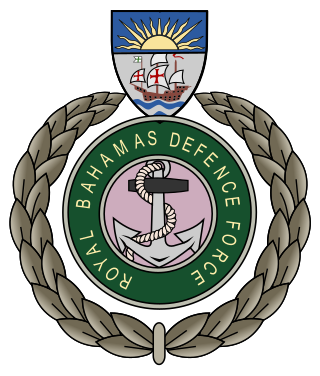
The Royal Bahamas Defence Force (RBDF) is the military of The Bahamas. Since The Bahamas does not have an army or an air force, its navy composes the entirety of its armed forces. Under The Defence Act, the Royal Bahamas Defence Force has been mandated to defend The Bahamas, protect its territorial integrity, patrol its waters, provide assistance in times of disaster, maintain order in conjunction with the law enforcement agencies of The Bahamas, and carry out any such duties as determined by the National Security Council. The Defence Force is also a member of CARICOM's Regional Security Task Force. The task force has seen action in the United Nations mandate in Haiti 1994.
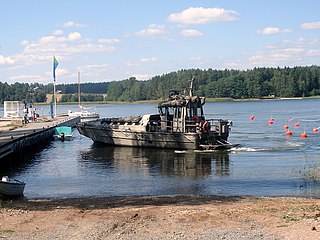
The Watercat M14 landing craft is a Jurmo-class type of military transport in use by the Royal Malaysia Police. The manufacturer is Marine Alutech Oy Ab, Finland. It is related to the Watercat M12 of the Finnish Navy.

Jehu-class landing craft are a class of military transport vessels used by the Finnish Navy. Manufactured by Marine Alutech under the designation Watercat M18 AMC, the boats can perform a multitude of tasks ranging from troop transport and landing operations to patrolling and escort tasks as well as combat and battle support operations. The Jehu-class boats are considerably larger and better armed that the preceding Jurmo-class landing craft.
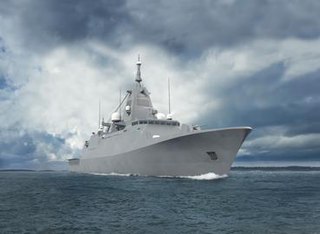
The Pohjanmaa class is a series of four multi-role corvettes currently under construction for the Finnish Navy as part of the Squadron 2020 project. Together with the existing four Hamina-class missile boats, the four new surface combatants will form the backbone of the Finnish Navy from the mid-2020s onwards. They will replace seven older vessels that have been or are due to be decommissioned; the minelayer Pohjanmaa, two Hämeenmaa-class minelayers and four Rauma-class missile boats.
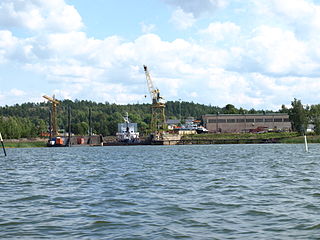
Marine Alutech is a leading designer and manufacturer of aluminium and composite boats in Finland. The company specializes in 5–27 meters boats and vessels for navies, coast guards, government agencies and port authorities. Marine Alutech has its own trading name Watercat.
